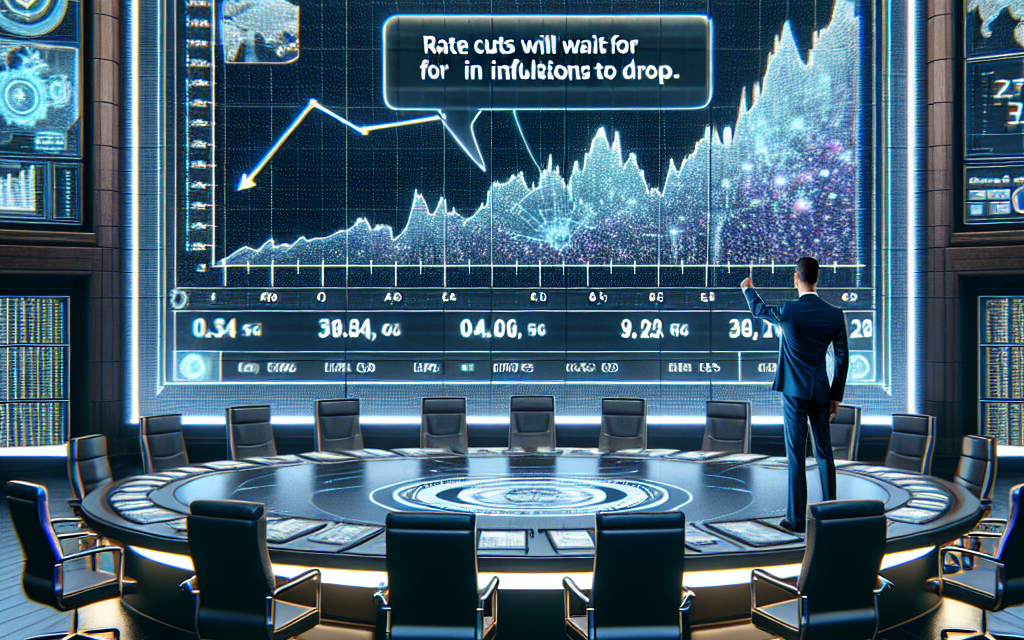“Patience Prevails: Fed’s Bowman Signals Rate Cuts on Hold Until Inflation Eases.”
Introduction
Federal Reserve Governor Michelle Bowman recently signaled that any potential interest rate cuts will be contingent upon a sustained decrease in inflation rates. In her remarks, she emphasized the importance of monitoring economic indicators closely, suggesting that the central bank remains committed to its inflation-targeting mandate. Bowman’s comments reflect a cautious approach, indicating that while the Fed is aware of the economic pressures facing consumers and businesses, it prioritizes achieving stable prices before considering any adjustments to the current monetary policy stance. This perspective underscores the Fed’s ongoing challenge of balancing economic growth with inflation control in a fluctuating economic landscape.
Fed’s Bowman: Key Insights on Rate Cuts
In recent remarks, Federal Reserve Governor Michelle Bowman provided critical insights into the central bank’s approach to interest rates, particularly in relation to inflation trends. Her statements underscore a cautious stance regarding potential rate cuts, emphasizing that any decision to lower rates will be contingent upon a sustained decrease in inflation. This perspective aligns with the Fed’s broader strategy of prioritizing price stability, which has become increasingly vital in the current economic landscape characterized by persistent inflationary pressures.
Bowman’s comments reflect a growing consensus among Fed officials that the fight against inflation is far from over. Despite some signs of easing in inflation rates, the overall economic environment remains complex. The Federal Reserve has been grappling with inflation levels that have consistently exceeded its target of 2%. As such, Bowman indicated that the central bank is committed to monitoring economic indicators closely before making any adjustments to the federal funds rate. This approach highlights the Fed’s reliance on data-driven decision-making, which is essential in navigating the uncertainties of the post-pandemic economy.
Moreover, Bowman’s emphasis on waiting for inflation to drop again before considering rate cuts suggests a strategic patience that is necessary in the current climate. The Fed’s previous rate hikes were implemented to combat rising prices, and any premature reduction in rates could risk reigniting inflation. This caution is particularly relevant given the potential for external factors, such as geopolitical tensions and supply chain disruptions, to influence inflation dynamics. By maintaining a vigilant stance, the Fed aims to ensure that any progress made in curbing inflation is not undermined by hasty policy changes.
In addition to inflation, Bowman also touched upon the importance of labor market conditions in shaping the Fed’s monetary policy. The labor market has shown resilience, with unemployment rates remaining low and job growth continuing in various sectors. However, the interplay between wage growth and inflation cannot be overlooked. As wages rise, there is a potential for increased consumer spending, which could further fuel inflationary pressures. Therefore, the Fed must carefully assess labor market trends alongside inflation data to make informed decisions regarding interest rates.
Furthermore, Bowman’s insights reflect a broader narrative within the Federal Reserve regarding the need for a balanced approach to monetary policy. While the central bank has a dual mandate to promote maximum employment and stable prices, the current economic environment necessitates a focus on inflation control. This prioritization does not imply a disregard for employment; rather, it underscores the interconnectedness of these objectives. A stable price environment is essential for sustainable economic growth, which ultimately supports job creation and wage increases.
In conclusion, Governor Michelle Bowman’s recent statements serve as a reminder of the complexities involved in monetary policy decision-making. Her indication that rate cuts will be contingent upon a clear and sustained decline in inflation highlights the Fed’s commitment to maintaining price stability. As the central bank navigates the challenges posed by inflation and labor market dynamics, it remains focused on a data-driven approach that prioritizes long-term economic health. This careful balancing act will be crucial as the Fed continues to adapt its policies in response to evolving economic conditions.
Understanding Inflation’s Role in Monetary Policy
Inflation plays a pivotal role in shaping monetary policy, influencing decisions made by central banks around the world. As economic conditions fluctuate, central banks, such as the Federal Reserve in the United States, closely monitor inflation rates to determine the appropriate stance for interest rates. Recently, Fed Governor Michelle Bowman emphasized that any potential rate cuts would be contingent upon a noticeable decline in inflation. This statement underscores the delicate balance that central banks must maintain between fostering economic growth and controlling inflation.
To understand the significance of inflation in monetary policy, it is essential to recognize what inflation represents. Essentially, inflation is the rate at which the general level of prices for goods and services rises, eroding purchasing power. When inflation is high, consumers find that their money does not stretch as far as it once did, which can lead to decreased consumer spending and, consequently, slower economic growth. Conversely, when inflation is low or negative, it can signal weak demand, prompting central banks to consider lowering interest rates to stimulate borrowing and investment.
In this context, the Federal Reserve employs a dual mandate: to promote maximum employment and to maintain stable prices. The interplay between these two objectives is complex, as actions taken to curb inflation can sometimes lead to higher unemployment rates. Therefore, the Fed must carefully assess economic indicators, including inflation rates, employment figures, and overall economic growth, before making decisions regarding interest rates.
Bowman’s recent remarks highlight the Fed’s cautious approach to monetary policy in the face of persistent inflation. While many economists and market participants may anticipate rate cuts as a means to invigorate the economy, the Fed’s commitment to controlling inflation remains paramount. This approach is particularly relevant in an environment where inflation has proven to be more resilient than expected, driven by factors such as supply chain disruptions, labor market constraints, and geopolitical tensions.
Moreover, the Fed’s decision-making process is influenced by the expectations of future inflation. If businesses and consumers anticipate rising prices, they may adjust their behavior accordingly, leading to a self-fulfilling cycle of inflation. Therefore, the Fed must not only react to current inflation data but also consider how its policies will shape expectations moving forward. This is where communication becomes crucial; the Fed’s guidance on future monetary policy can help anchor inflation expectations, thereby influencing economic behavior.
As the Fed navigates this complex landscape, it is essential to recognize that monetary policy operates with a lag. Changes in interest rates do not immediately translate into shifts in economic activity. Consequently, the Fed must be forward-looking, weighing the potential impacts of its decisions on inflation and employment over time. This necessitates a careful analysis of economic indicators and a willingness to adapt as conditions evolve.
In conclusion, the relationship between inflation and monetary policy is intricate and multifaceted. Fed Governor Bowman’s indication that rate cuts will be postponed until inflation shows signs of decline reflects a broader commitment to maintaining price stability. As the Fed continues to assess economic conditions, it remains focused on balancing the dual mandate of fostering employment while ensuring that inflation does not spiral out of control. This careful calibration is essential for sustaining long-term economic growth and stability.
The Impact of Rate Cuts on Economic Growth
The recent comments from Federal Reserve Governor Michelle Bowman regarding the timeline for potential rate cuts have sparked significant interest among economists and market analysts. Bowman’s assertion that any reductions in interest rates will be contingent upon a sustained decrease in inflation underscores the delicate balance the Federal Reserve must maintain in fostering economic growth while controlling price stability. The implications of rate cuts on economic growth are multifaceted and warrant careful consideration.
To begin with, it is essential to understand that interest rates play a crucial role in shaping the economic landscape. When the Federal Reserve lowers rates, borrowing costs decrease, which can stimulate consumer spending and business investment. This increase in demand often leads to higher production levels, job creation, and ultimately, economic expansion. However, the timing and context of such cuts are critical. If inflation remains elevated, reducing rates could exacerbate price pressures, leading to a cycle of rising costs that undermines the very growth the Fed seeks to promote.
Moreover, the relationship between interest rates and inflation is complex. In a low-inflation environment, rate cuts can be a powerful tool for encouraging economic activity. Consumers are more likely to take on loans for big-ticket items, such as homes and cars, when interest rates are low. Similarly, businesses may invest in expansion and innovation, confident that the cost of financing will not erode their profit margins. However, when inflation is high, as it has been in recent years, the Fed faces a dilemma. Lowering rates in such an environment could lead to overheating, where demand outstrips supply, further driving up prices.
In addition to the immediate effects on consumer behavior and business investment, the broader economic implications of rate cuts must also be considered. For instance, lower interest rates can lead to a weaker currency, which may boost exports by making them more competitively priced in international markets. This can provide a much-needed lift to domestic manufacturers and contribute to overall economic growth. However, a weaker currency can also increase the cost of imports, potentially leading to higher prices for consumers and businesses reliant on foreign goods.
Furthermore, the psychological impact of rate cuts should not be overlooked. When the Federal Reserve signals its intent to lower rates, it can instill confidence in the markets and among consumers. This optimism can lead to increased spending and investment, creating a self-reinforcing cycle of growth. Conversely, if rate cuts are perceived as a response to economic weakness, they may signal uncertainty, leading to a more cautious approach from consumers and businesses alike.
As the Federal Reserve navigates these complex dynamics, it is clear that any decision regarding rate cuts will be made with careful consideration of inflation trends. The central bank’s commitment to ensuring price stability while fostering economic growth reflects a nuanced understanding of the interconnectedness of these factors. In conclusion, while rate cuts can provide a significant boost to economic activity, their timing and context are paramount. The Fed’s cautious approach, as indicated by Bowman’s recent remarks, suggests a recognition that sustainable growth must be built on a foundation of stable prices. As such, the path forward will require a delicate balancing act, one that prioritizes both immediate economic needs and long-term stability.
Analyzing Current Inflation Trends and Predictions
In recent discussions surrounding monetary policy, the Federal Reserve’s stance on interest rates has garnered significant attention, particularly in light of ongoing inflation trends. Federal Reserve Governor Michelle Bowman has made it clear that any potential rate cuts will be contingent upon a noticeable decline in inflation. This statement underscores the Fed’s commitment to its dual mandate of promoting maximum employment and stabilizing prices, while also reflecting the complexities of the current economic landscape.
To understand the implications of Bowman’s remarks, it is essential to analyze the current inflation trends. Over the past year, inflation has exhibited a persistent upward trajectory, driven by various factors including supply chain disruptions, increased consumer demand, and rising energy prices. The Consumer Price Index (CPI), a key measure of inflation, has shown fluctuations that have kept policymakers on high alert. While there have been some signs of moderation in certain sectors, such as used cars and housing, core inflation—excluding volatile food and energy prices—remains stubbornly elevated.
As we delve deeper into the inflationary pressures, it becomes evident that the labor market plays a crucial role. The tight labor market has contributed to wage growth, which, while beneficial for workers, can also lead to increased costs for businesses. These costs are often passed on to consumers, further fueling inflation. Consequently, the Fed is faced with the challenge of balancing the need for economic growth with the imperative to control inflation. This balancing act is particularly delicate, as premature rate cuts could exacerbate inflationary pressures, while maintaining high rates for too long could stifle economic recovery.
Looking ahead, economists and analysts are closely monitoring various indicators to predict the trajectory of inflation. Factors such as consumer spending patterns, global supply chain stability, and geopolitical developments will play pivotal roles in shaping future inflation rates. For instance, if consumer demand continues to outpace supply, inflation may remain elevated, prompting the Fed to maintain its current interest rate levels. Conversely, if supply chain issues are resolved and production ramps up, there could be a downward shift in prices, potentially paving the way for rate cuts.
Moreover, the Fed’s communication strategy is critical in managing market expectations. By signaling that rate cuts will not occur until inflation shows a sustained decline, the Fed aims to anchor inflation expectations among consumers and businesses. This approach is vital in preventing a self-fulfilling cycle of rising prices, where expectations of future inflation lead to increased spending and further price hikes. Therefore, the Fed’s commitment to monitoring inflation trends closely is not merely a matter of policy; it is a strategic move to maintain credibility and foster economic stability.
In conclusion, the current inflation landscape presents a complex challenge for the Federal Reserve. Governor Bowman’s indication that rate cuts will wait for a significant drop in inflation reflects a cautious and measured approach to monetary policy. As inflation trends continue to evolve, the Fed’s decisions will be guided by a careful analysis of economic indicators and market dynamics. Ultimately, the path forward will require a delicate balance between fostering economic growth and ensuring price stability, a task that remains at the forefront of the Fed’s agenda.
The Federal Reserve’s Strategy: Patience vs. Action
In recent statements, Federal Reserve Governor Michelle Bowman has emphasized the importance of a measured approach to monetary policy, particularly in light of ongoing inflationary pressures. Her remarks underscore a broader strategy within the Federal Reserve that prioritizes patience over immediate action when it comes to interest rate adjustments. This perspective is particularly relevant as the central bank navigates a complex economic landscape characterized by fluctuating inflation rates and varying economic indicators.
Bowman’s assertion that rate cuts will not be considered until inflation shows a consistent downward trend reflects a cautious stance that many economists and policymakers support. The rationale behind this approach is rooted in the understanding that inflation, while currently elevated, can be influenced by a multitude of factors, including supply chain disruptions, labor market dynamics, and global economic conditions. Therefore, the Federal Reserve aims to avoid premature rate cuts that could potentially exacerbate inflationary pressures rather than alleviate them.
Moreover, the Federal Reserve’s commitment to monitoring inflation closely is indicative of a broader strategy that seeks to balance economic growth with price stability. By maintaining higher interest rates for an extended period, the central bank hopes to temper consumer demand and curb inflation without stifling economic recovery. This delicate balancing act requires a nuanced understanding of economic indicators and a willingness to adapt to changing circumstances. As such, the Fed’s approach is not merely reactive; it is a proactive strategy designed to foster long-term economic stability.
In addition to inflation, the Federal Reserve is also attentive to other economic indicators, such as employment rates and consumer spending. These factors play a crucial role in shaping the central bank’s decisions regarding interest rates. For instance, if employment figures remain robust and consumer spending continues to grow, the Fed may feel less pressure to implement rate cuts, even if inflation shows signs of easing. Conversely, should economic conditions deteriorate, the Fed may need to reassess its strategy and consider more aggressive measures to stimulate growth.
Furthermore, Bowman’s comments highlight the importance of communication in monetary policy. By clearly articulating the Fed’s rationale for maintaining current interest rates, she aims to manage market expectations and provide clarity to investors and consumers alike. This transparency is essential in fostering confidence in the central bank’s decisions and ensuring that economic participants can make informed choices based on anticipated monetary policy actions.
As the Federal Reserve navigates this intricate landscape, it is clear that patience will be a key component of its strategy. The central bank recognizes that the path to sustainable economic growth and stable prices is not always linear. Therefore, it is essential to remain vigilant and responsive to emerging economic trends while avoiding hasty decisions that could undermine progress.
In conclusion, the Federal Reserve’s current strategy, as articulated by Governor Bowman, reflects a commitment to patience in the face of persistent inflation. By prioritizing a careful assessment of economic conditions and maintaining a steady course on interest rates, the central bank aims to foster an environment conducive to long-term growth and stability. As the economic landscape continues to evolve, the Fed’s approach will undoubtedly adapt, but the emphasis on measured action over impulsive decisions will remain a cornerstone of its monetary policy framework.
Market Reactions to Fed’s Stance on Rate Cuts
In recent statements, Federal Reserve Governor Michelle Bowman has signaled that any potential cuts to interest rates will be contingent upon a sustained decrease in inflation. This perspective has significant implications for market dynamics, as investors and analysts closely monitor the Fed’s stance on monetary policy. The anticipation surrounding interest rate adjustments often leads to fluctuations in various financial markets, including equities, bonds, and commodities. As such, Bowman’s remarks have prompted a reevaluation of market expectations regarding the timing and magnitude of future rate cuts.
Initially, the stock market reacted with a degree of caution following Bowman’s comments. Investors, who had been hoping for a more immediate pivot towards lower rates, found themselves reassessing their positions. The prospect of prolonged high interest rates can dampen corporate earnings growth, as borrowing costs remain elevated. Consequently, sectors that are particularly sensitive to interest rate changes, such as real estate and utilities, experienced notable volatility. This reaction underscores the interconnectedness of monetary policy and market performance, where the Fed’s decisions can have far-reaching consequences on investor sentiment and asset valuations.
Moreover, the bond market exhibited a similar response, with yields on government securities reflecting the uncertainty surrounding future rate cuts. As Bowman emphasized the need for inflation to show consistent signs of decline before any rate adjustments could be considered, bond traders began to recalibrate their expectations. The yield curve, which represents the relationship between interest rates and the maturity of debt, became a focal point of analysis. A flattening yield curve often signals investor apprehension about economic growth, and in this context, the market’s reaction to the Fed’s cautious approach may indicate a broader concern about the sustainability of the current economic expansion.
In addition to equities and bonds, commodities markets also felt the impact of Bowman’s statements. Inflationary pressures have historically influenced commodity prices, particularly in sectors such as energy and agriculture. As the Fed maintains its current stance, the potential for inflation to remain elevated could lead to increased volatility in these markets. Investors in commodities may adopt a more defensive posture, hedging against the risk of persistent inflation that could erode purchasing power. This dynamic illustrates how the Fed’s monetary policy decisions can ripple through various asset classes, shaping investment strategies and market behavior.
Furthermore, the global implications of the Fed’s stance cannot be overlooked. As the U.S. central bank navigates its monetary policy, other central banks around the world are also grappling with their own inflationary challenges. The interconnectedness of global markets means that the Fed’s decisions can influence foreign exchange rates and international capital flows. For instance, a stronger dollar, driven by higher interest rates, can impact emerging markets that rely on dollar-denominated debt. Consequently, investors must remain vigilant, as shifts in U.S. monetary policy can have cascading effects on global economic stability.
In conclusion, Federal Reserve Governor Michelle Bowman’s indication that rate cuts will be delayed until inflation shows a consistent decline has elicited a multifaceted response across financial markets. The cautious tone has led to increased volatility in equities, adjustments in bond yields, and strategic shifts in commodity investments. As market participants navigate this complex landscape, the interplay between the Fed’s monetary policy and broader economic conditions will remain a critical focal point for investors seeking to understand the evolving financial environment.
Future Implications of Delayed Rate Cuts on Consumers
The recent comments from Federal Reserve Governor Michelle Bowman regarding the timeline for potential interest rate cuts have significant implications for consumers. As she indicated, the Fed is unlikely to lower rates until there is a clear and sustained decline in inflation. This stance reflects a cautious approach aimed at ensuring that inflationary pressures do not re-emerge, which could destabilize the economy. Consequently, consumers must navigate a landscape where borrowing costs remain elevated for an extended period, influencing various aspects of personal finance.
One of the most immediate effects of delayed rate cuts is the continued high cost of borrowing. For consumers, this translates into higher interest rates on mortgages, auto loans, and credit cards. As a result, individuals looking to purchase homes or finance large purchases may find themselves facing increased monthly payments, which can strain household budgets. Moreover, potential homebuyers may be discouraged from entering the market, leading to a slowdown in housing demand. This situation could exacerbate existing challenges in the real estate sector, where affordability has already become a pressing issue for many.
In addition to the impact on borrowing costs, the decision to hold off on rate cuts may also affect consumer confidence. When interest rates remain high, consumers may feel less inclined to spend, opting instead to save in anticipation of better financial conditions in the future. This shift in behavior can lead to a decrease in overall economic activity, as consumer spending is a critical driver of growth. Businesses, in turn, may respond to reduced consumer demand by scaling back investments or delaying expansion plans, which could further dampen economic prospects.
Furthermore, the prolonged period of elevated interest rates can have implications for savings and investment strategies. While higher rates can benefit savers by offering better returns on savings accounts and fixed-income investments, the overall economic uncertainty may lead consumers to adopt a more conservative approach to their finances. This cautious mindset can hinder long-term financial planning, as individuals may prioritize liquidity over growth, potentially missing out on opportunities for wealth accumulation.
As inflation remains a key concern, consumers must also be aware of the potential for rising prices to erode purchasing power. Even if interest rates stabilize, if inflation continues to outpace wage growth, consumers may find it increasingly difficult to maintain their standard of living. This scenario underscores the importance of monitoring economic indicators and adjusting personal financial strategies accordingly.
In light of these factors, it is essential for consumers to remain informed about the Federal Reserve’s actions and the broader economic landscape. Understanding the implications of delayed rate cuts can empower individuals to make more informed decisions regarding their finances. Whether it involves refinancing existing loans, adjusting spending habits, or exploring investment opportunities, being proactive in response to economic conditions can help mitigate the challenges posed by a high-interest-rate environment.
In conclusion, the Fed’s decision to delay rate cuts until inflation shows signs of a sustained decline carries significant implications for consumers. From higher borrowing costs to shifts in consumer confidence and spending behavior, the effects are far-reaching. By staying informed and adapting their financial strategies, consumers can navigate this complex landscape and work towards achieving their financial goals despite the challenges posed by the current economic climate.
Q&A
1. **Question:** What did Fed’s Bowman indicate regarding interest rate cuts?
**Answer:** Fed’s Bowman indicated that interest rate cuts will be delayed until inflation shows a significant decline.
2. **Question:** Why is the Fed cautious about cutting rates?
**Answer:** The Fed is cautious about cutting rates because they want to ensure that inflation is under control and moving towards their target.
3. **Question:** What is the Fed’s target inflation rate?
**Answer:** The Fed’s target inflation rate is typically around 2%.
4. **Question:** How does inflation impact the decision to cut rates?
**Answer:** High inflation can lead the Fed to maintain or increase rates to stabilize prices, while low inflation may prompt rate cuts to stimulate the economy.
5. **Question:** What economic indicators does the Fed monitor before deciding on rate cuts?
**Answer:** The Fed monitors inflation rates, employment data, GDP growth, and other economic indicators.
6. **Question:** What could be the consequences of premature rate cuts?
**Answer:** Premature rate cuts could lead to a resurgence in inflation, undermining economic stability and the Fed’s credibility.
7. **Question:** When might the Fed consider cutting rates according to Bowman’s statement?
**Answer:** The Fed might consider cutting rates when there is clear evidence that inflation is consistently declining towards their target level.
Conclusion
Fed’s Bowman suggests that any potential rate cuts will be contingent upon a sustained decrease in inflation, indicating a cautious approach to monetary policy that prioritizes economic stability over immediate easing measures. This stance reflects the Fed’s commitment to ensuring that inflation is firmly under control before making adjustments to interest rates, signaling a wait-and-see strategy in response to economic conditions.





